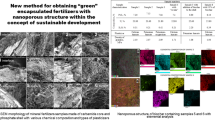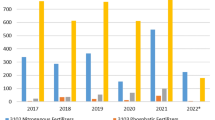Abstract
The work is devoted to improving the technology of obtaining organo-mineral fertilizers by modifying the composition of the organic shell, which allows the formation of its developed nanoporous structure. Perspective directions of the “green” transition of agriculture in the concept of sustainable innovative outpacing are substantiated. The relevance of using granular products with a porous structure in chemical production and the agricultural industry is given. A review of methods for obtaining granules with a nanoporous structure is also carried out. The necessity of creating a new type of fertilizers, combining nutrients included in the composition of mineral fertilizers and organic elements, has been substantiated. The technological bases of encapsulation of mineral fertilizers with an organic shell are presented. A new composition of the shell for encapsulation has been proposed, in which biochar is used as an additional pore-forming agent. The results of studying the structure of granules of organo-mineral fertilizers with biochar in the shell are presented.
Access this chapter
Tax calculation will be finalised at checkout
Purchases are for personal use only
Similar content being viewed by others
References
Wang C (2015) Explaining connotation of regional green transition. In: Proceedings of the 2015 International conference on industrial technology and management science (ITMS 2015), 34, 1203–1205
Sutherland LA, Darnhofer I, Wilson GA, Zagata L (2015) Transition pathways towards sustainability in agriculture: case studies from Europe. CABI Publishing
Shen J, Zhu Q, Jiao X, Ying H, Wang H, Wen X, Xu W, Li T, Cong W, Liu X, Hou Y, Cui Z, Oenema O, Davies WJ, Zhang F (2020) Agriculture green development: a model for China and the world. Front Agri Sci Eng 7(1):5–13
European Commission (2021) The European Green Deal
European Commission (2021) Communication from the commission to the European Parliament, the Council, the European economic and social committee and the committee of the regions ‘Fit for 55’: delivering the EU's 2030 Climate Target on the way to climate neutrality. COM/2021/550 final
World Economic Forum (2021) The Global Risks Report 2021
European Environment Agency (2021) EEA greenhouse gases—data viewer. Data viewer on greenhouse gas emissions and removals, sent by countries to UNFCCC and the EU Greenhouse Gas Monitoring Mechanism (EU Member States)
UNFCCC (2021). National Inventory Submissions 2021
UNFCCC (2021) Ukraine. 2021 Common Reporting Format (CRF)
State Statistics Service of Ukraine (2021) Application of mineral and organic fertilizers (1919–2020)
Resolution of the Cabinet of Ministers of Ukraine (2021) On approval of the National Economic Strategy for the period up to 2030” from 03.03.2021 No. 179
Ministry of Environmental Protection and Natural Resources of Ukraine (2021) Draft Concept of “green” energy transition of Ukraine until 2050
Artyukhov A, Vakal S, Shkola V, Vakal V, Yanovska A (2021) Obtaining of the novel organo-mineral fertilizers in pan granulators: technological fundamentals. In: Ivanov V, Pavlenko I, Liaposhchenko O, Machado J, Edl M (eds) Advances in design, simulation and manufacturing IV. DSMIE 2021. Lecture Notes in Mechanical Engineering, 207–217
Shkola V, Prokopenko O, Stoyka A, Nersesov V, Sapiński A (2021) Green project assessment within the advanced innovative development concept. Estudios de Economia Aplicada 39(5)
Vakal S, Yanovska A, Vakal V, Artyukhov A, Shkola V, Yarova T, Dmitrikov V, Krmela J, Malovanyy M (2021) Minimization of soil pollution as a result of the use of encapsulated mineral fertilizers. J Ecol Eng 22(1):221–230
Kotenko O, Domashenko M, Shkola V (2019) Production costs decreasing by introduction of energy-efficient technologies within the enterprise’s counter-crisis management strategy. Inter J Ecol Econ Statis 40(3):88–97
Kurbatova T, Skibina T (2019) Renewable energy policy in Ukraine's household sector: measures, outcomes, and challenges. In: IEEE International Conference on Modern Electrical and Energy Systems, 234–237
Kurbatova T, Sotnyk I, Kubatko O, Baranchenko Y, Arakpogun E, Roubik H (2020) State support policy for renewable energy development in emerging economies: the case of Ukraine. Inter J Global Environ Issues 19(1–3):26–52
Trypolska G, Kruvda O, Kurbatova T, Andrushchenko O, Suleymanov C, Brydun Y (2021) Impact of new renewable energy capacities on employment in Ukraine in 2021–2030. Inter J Energy Econ Policy 11(6):98–105
Artyukhov A, Artyukhova N, Krmela J, Krmelová V (2020) Granulation machines with highly turbulized flows: creation of software complex for technological design. In: IOP Conference Series: Materials Science and Engineering 776(1):Article no. 012018
Artyukhov A, Artyukhova N, Krmela J, Krmelová V (2020) Complex designing of granulation units with application of computer and software modeling: case “Vortex granulator”. Mat Sci Eng 776(1):Article no. 012016
Artyukhov A, Artyukhova N (2018) Utilization of dust and ammonia from exhaust gases: new solutions for dryers with different types of fluidized bed. J Environ Health Sci Eng 16(2):193–204
Artyukhov AE, Artyukhova NO (2019) Technology and the main technological equipment of the process to obtain N4HNO3 with Nanoporous Structure. Springer Proc Phys 221:585–594
Artyukhov AE, Ivaniia AV (2017) Obtaining porous ammonium nitrate in multistage and multifunctional vortex granulators. Naukovyi Visnyk Natsionalnoho Hirnychoho Universytetu 6:68–75
Ivaniia AV, Artyukhov AY, Olkhovyk AI (2019) Hydrodynamic and thermodynamic conditions for obtaining a nanoporous structure of ammonium nitrate granules in vortex granulators. Springer Proc Phys 221:257–268
Artyukhov AE, Krmela J, Gavrylenko OM (2019) Evaluation of the impact made by the hydrodynamic regime of the granulation equipment operation on the nanoporous structure of N4HNO3 granules. J Nano Elect Phys 11(3):03033
Yukhymenko M, Ostroha R, Artyukhov A (2016) Hydrodynamic and kinetic processes of the mineral fertilizer granules encapsulating in the multistage device with suspended layer. Eastern-European J Enter Technol 6(6–84):22–28
Ostroha R, Yukhymenko M, Yakushko S, Artyukhov A (2017) Investigation of the kinetic laws affecting the organic suspension granulation in the fluidized bed. Eastern-European J Enterprise Technol 4(1):4–10
Chuah CY, Li W, Yanqin Yang Y, Bae T-H (2020) Evaluation of porous adsorbents for CO2 capture under humid conditions: the importance of recyclability. Chem Eng J Adv 3:100021
Broom D (2021) Characterizing adsorbents for gas separations Measurement needs and laboratory techniques (white paper). Hiden Isochema
Acknowledgements
This research work had been supported by the Ministry of Science and Education of Ukraine under the project No 0120U102003 “process of formation of the novel ecologically safe fertilizers with prolonged action based on the phosphorite deposits raw materials”.
Author information
Authors and Affiliations
Corresponding author
Editor information
Editors and Affiliations
Rights and permissions
Copyright information
© 2023 The Author(s), under exclusive license to Springer Nature Switzerland AG
About this paper
Cite this paper
Vakal, S.V., Vakal, V.S., Artyukhov, A.E., Shkola, V.Y., Yanovska, A.O. (2023). Selection of Optimal Technological Parameters for Obtaining Encapsulated Organic-Mineral Fertilizers with Nanoporous Structure. In: Fesenko, O., Yatsenko, L. (eds) Nanomaterials and Nanocomposites, Nanostructure Surfaces, and Their Applications . Springer Proceedings in Physics, vol 279. Springer, Cham. https://doi.org/10.1007/978-3-031-18096-5_23
Download citation
DOI: https://doi.org/10.1007/978-3-031-18096-5_23
Published:
Publisher Name: Springer, Cham
Print ISBN: 978-3-031-18095-8
Online ISBN: 978-3-031-18096-5
eBook Packages: Physics and AstronomyPhysics and Astronomy (R0)




